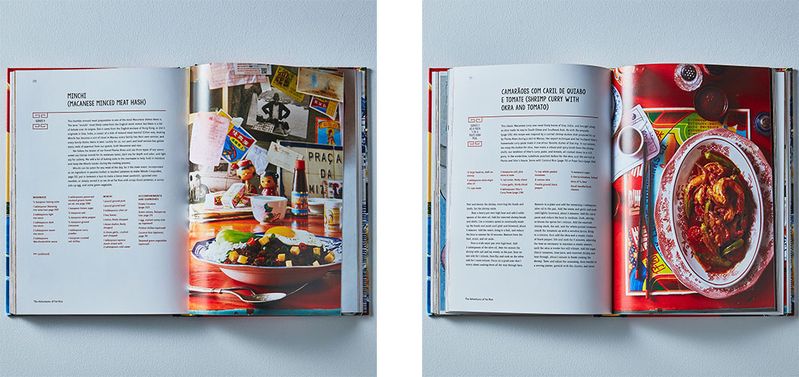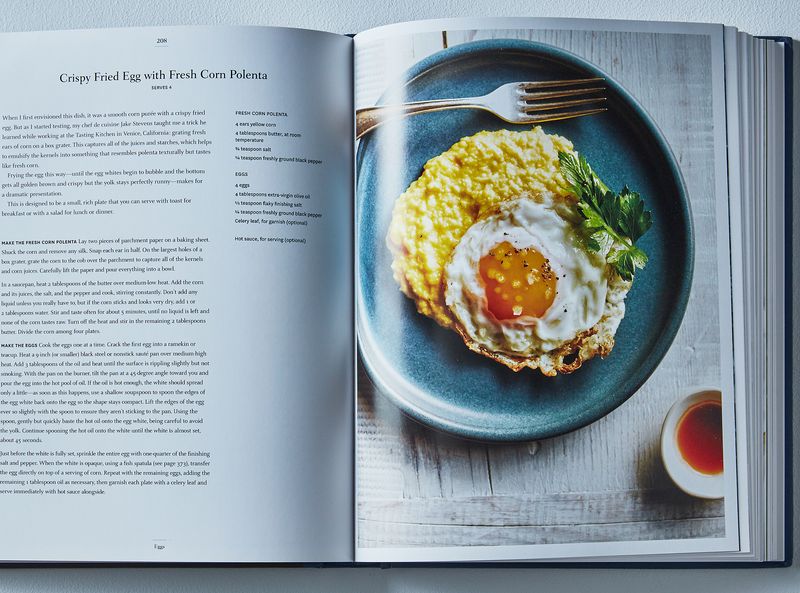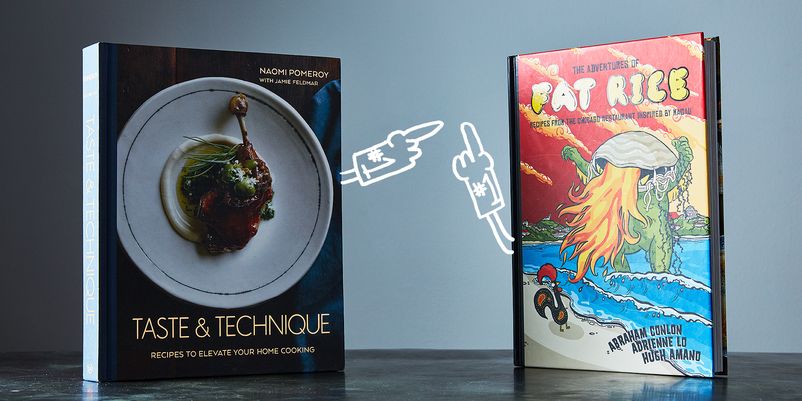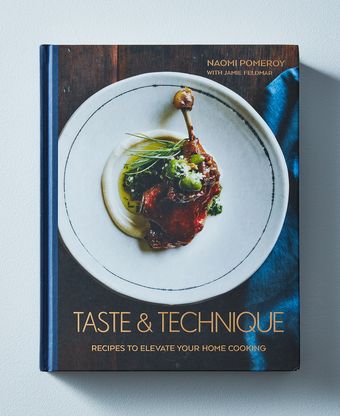In the boxing world, they say “styles make fights.” Apparently, the same goes for cookbook tournaments. I took my time with this, having never judged anything outside of a cosplay tournament in 2002. (True story—it was a pressure situation.)
This competition was, well, a little different—but with no less pressure. I looked at everything in both books, from the design and aesthetics to accessibility to whether or not the recipes worked and how they tasted.
Let’s do this round by round.
Round 1: The books themselves.
Taste & Technique is from Naomi Pomeroy, owner and chef of the Portland restaurant Beast, and her co-writer Jamie Feldmar. First: Beast and Pomeroy’s bar Expatriate will pretty much be the only places I go the next time I’m in Portland. But the book itself is a classic and proper chef’s take on making your meals at home gorgeous and delicious, from the ground up.
Her recipes take you through all the steps you’ll need to add to your foundation as a home cook—you won’t just get dinner at the end of cooking a recipe, but you’ll walk away a better and more studied cook. And when I say all the steps, there's an emphasis on all; these recipes can be long. Take the French onion soup: The headnote specifies that the soup will “take a bit of effort” over two days, but Pomeroy assures you you’ll be glad. And what you’ll come away with? Not just a rich, beautiful soup—the knowledge that you can replace up to 2 cups of the stock in this kind of soup with leftover braising liquid. Smart tip.

The Adventures of Fat Rice is from a completely different dimension in a different universe. The owners of Chicago’s famed Fat Rice restaurant, Abraham Conlon and Adrienne Lo, along with Hugh Amano, have transformed the traditional cookbook. This is a comic book merged with recipes—there are graphic illustrations and how-tos (see: “Shaping the Empada,” p. 129, and “Shaping Papo Seco,” p. 266, among others); comic strips with whole recipes (see: “Attack of the Chilli Clam,” p.158); they even have dishes spelled out in dialogue bubbles. But it’s not enough to ever lose you—there are photos of ingredients and dishes throughout for your reference. Flipping through this book is fun ride; I could tell I was in for a lot of new-to-me food and ingredients, and I was excited to dive in.
Round 1 Winner: Fat Rice, for taking the concept of a cookbook and turning it on its head.
Round 2: The food.
As I mentioned, Taste & Technique is not a simple cookbook. The recipes can be long and few fit on one page. But it does simplify the complex—it takes philosophies from meals you already know and builds on them. That familiar French onion soup? You make it better with rich braising liquid. Or the the tomato soup and grilled cheese you loved from your childhood? In Taste & Technique, that’s too pedestrian, in a good way: Pomeroy urges you to make smoky tomato veloute with puff pastry Parmesan straws instead. I smoked the onions before I blended them with the tomatoes, and I wasn’t mad about it. That feeling started to wear off as I made the puff pastry straws from scratch, though. They tasted amazing, but when I have to puff my own pastry, I’m tempted to tap out.

The Balsamic Braised Short Ribs I made were delicious, as was the Crispy Fried Egg with fresh Corn Polenta, which is now a brunch staple at my house. I’ll be making these again. This book is not for the faint of heart, and it’s for the right kind of cook: If you’re invested, you’ll end up with amazing food.
The Adventures of Fat Rice is crazy awesome and at times, crazy hard. The introduction reads: “The recipes in this book reflect a cuisine that at once combines and contrasts aspects of the many cultures it has grown from. As such, many words and names will be foreign to you; others will seem familiar but might have different meanings than you are used to. A daunting aspect of our study of Macanese cooking and its related cuisines is the sheer number of countries and people that have left their mark on how we interpret the food today.” As promised, the recipes can be intense—filled with ingredients that need to be sourced, or techniques you may not have heard of. In other words, those graphic illustrations and how-tos will be your friend. Going through this book, I’m blown away by the work and involvement of the food they serve in their Chicago restaurant.
I land on the Potstickers Royal with Crispy Crepe to cook first, a four-page recipe with a 2-page graphic spread on how to fold, pinch, steam, and flip the potstickers. It’s a tricky recipe, but the flavor here is some of the best I’ve eaten—they land in my top 3 potstickers of all time. And the authors try to ease any intimidation in the headnote: “And remember, you aren’t selling these in a crowded restaurant (you aren’t, right?), so even the ones that don’t pop out under a perfect crepe will still taste delicious.”
The Malay Style Vegetable Curry was up next, served with their coconut rice. It was fantastic, but was super hard for me to make. I had to reference 5 different recipes in the book to make this right: The curry itself, their Malacca sweet curry powder, the Malay curry sauce, Balichão (Macanese shrimp paste), and their coconut rice. (Though the powder recipe makes a whole cup and keeps for up to three months; the more you cook from this book and the more you amass components, the easier it gets.)
Round 2 Winner: Taste & Technique, for already giving me new staples.
Each book won a round, which means we will need a deciding championship: At the end of the day, which book will I use more? Which one will I return to? Which will I keep in my kitchen? While The Adventures of Fat Rice is more fun to discuss with friends—and more fun to flip through and learn tips by way of comic strips—I just can't see myself using the book as regularly as I do Taste & Technique. I felt myself wanting to make and eat the food in Taste & Technique more than I did Fat Rice; recipes like their Roasted Pigeon or Pig Ear Salad didn't get my creative juices flowing, but they do get points for piquing my curiosity.
And so, moving on to the next round, my winner, is Taste & Technique.



36 Comments
Nice review, by the way. I really liked the sections and the clear writing.
Even with my bias I think this is the best review yet. What I love about it is how he broke it down. One as a book and one as a source of usable recipes. I know plenty of people who will rave about Mastering the Art of French Cooking or The Joy of Cooking. I have a hard time ever going to either as neither "clicks" with me. So to get a review on just the book it's self can help me understand what I would get out of both the review and the cookbook.
I am fairly certain both books are going on my Amazon wishlist but I liked how he chose to reach his conclusion and what his conclusion was.
And Diana, so love that you're an active part of this Piglet. Thank you!